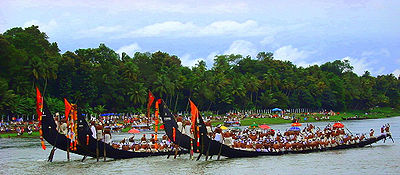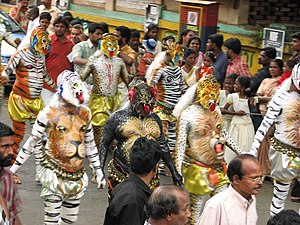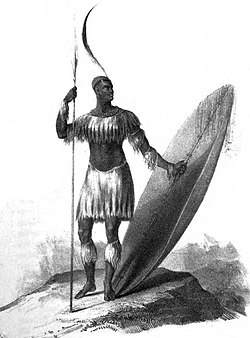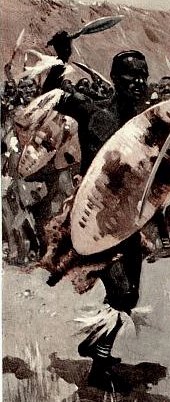
|
The festival commemorates the Vamana avatar of Vishnu and the subsequent homecoming of the legendary Emperor Mahabali. It is the state festival of Kerala and falls during the month of Chingam (August–September) and lasts for ten days. The festival is marked by various festivities, including intricate flower carpets, elaborate banquet lunches, snake boat races, Onappottan,Athachamayam in Tripunithura, Kaazhchakkula in Guruvayoor, Puli Kali, Kaikottikkali, Kummaattikkali, Onathaar, Onachamayam, Onathallu, Thrikkaakarayappan, Thumbi thullal, Onavillu etc. This is one of the very few festivals which is celebrated with most number of cultural elements.
Significance
Onam is an ancient festival which still survives in modern times. Kerala's rice harvest festival and the Festival of Rain Flowers, which fall on the Malayalam month of Chingam, celebrates the Asura King Mahabali's annual visit from Patala (the underworld). Onam is unique since Mahabali has been revered by the people of Kerala since prehistory.According to the legend, Kerala witnessed its golden era during the reign of King Mahabali. The Brahma-Vaivarta Puranam explains that Lord Vishnu wanted to curb the pride of Indra; and therefore positioned Mahabali in great power.
The Bhagavata Purana reads "He [Vishnu] will take the kingdom away from Purandara [Lord Indra] and give it to Bali Maharaja."
The subjects under Mahabali's reign were happy and prosperous and the king was highly regarded, so much so that even the gods under Indra became jealous of Mahabali as was intened by Vishnu, and they approached Vishnu claiming that Mahabali is now equivalent to an Indra. Once Vishnu was assured that Indra's pride has been contained and that a world with two Indras represents imbalance, Vishnu assumed the form of a dwarf: Vamana. Vamana requested three steps of land for him to live in. Given a promise of three steps of land by King Mahabali against the warning given by his Guru Sukracharya, Vamana, enlarged himself to such dimensions as to stride over the three worlds. He had grown so huge that he could step from heaven to earth, and earth to the lower worlds in two simple steps. King Mahabali unable to fulfill the promise of three paces of land to the Supreme God, offers his head for the third step. Thus, Vamana places his foot on King Mahabali's head and sends him down to the netherworld. Being worshipped however, by Mahabali, and his ancestor Prahláda, he conceded to them the sovereignty of Sutala (netherworld).
However, as Mahabali was equivalent to Indra, he had to wait until the next Yuga where he would be the Indra. In the meantime, with the grace of Vishnu, Mahabali visited his people on an annual basis. Vishnu served Mahabali as a gatekeeper in Sutala as the Lord himself serves his greatest devotees.
It is this visit of Mahabali that is celebrated as Onam every year. People celebrate the festival in a grand way and impress upon their dear King that they are happy and wish him well.
The rich cultural heritage of Kerala comes out in its best form and spirit during the ten-day festival. The central feature of Onam is the grand feast called Onasadya, prepared on Thiruonam. It is a nine-course meal consisting of 11 to 13 essential dishes. Onasadya is served on banana leaves and people sit on a mat laid on the floor to have the meal.
Another popular feature of Onam is Vallamkali, the Snake Boat Race, held on the Pamba River, in which decorative boats oared by hundreds of boatmen race amidst chanting of songs and cheering by spectators and viewers.
There is also a tradition to play games, collectively called Onakalikal, on Onam. Men go in for rigorous sports like Talappanthukali (played with a ball), Ambeyyal (Archery), Kutukutu and combats called Kayyankali and Attakalam. Women indulge in cultural activities. They make intricately designed flower mats called, Pookalam in the front courtyard of the house to welcome King Mahabali. Kaikotti kali and Thumbi Thullal are two dances performed by women on Onam. Folk performances like Kummatti kali and Pulikali add to the zest of celebrations.
Mahabali's rule is considered the golden era of Kerala. The following song is often sung over Onam:
The legend
Mahabali was the grandson of Prahlada (son of Hiranyakashyapa who was slain by Vishnu in his Narasimha Avatara). Prahlad, despite being an Asura, had great faith in Vishnu. Mahabali learned the act of love and devotion to Lord Vishnu as a child, from Prahlada.Mahabali conquers the three worlds
Kashyapa had two wives, Diti and Aditi, who were the parents of the demons and the gods (Asuras and Devas) respectively. Kashyapa, who had gone to the Himalayas to do penance, on his return found Aditi weeping. By divine insight, Kashyapa instantly recognised the cause of her grief. He tried to console her saying that nothing happens in the world without divine will and people should go on doing their duties. He asked her to pray to Vishnu and taught her Payovrata, a ritual that has to be observed from the 12th day of the bright half of Karthika (Sukla-paksha Dvadasi). Since Aditi carried out the Vrata with a pious heart, Vishnu appeared before her and informed her that he would help Indra.Alternatively, the Devas were very annoyed as Mahabali became the ruler of all the three worlds having defeated the Devas. Devas, the celestial beings, were annoyed and jealous. The gods approached Vishnu and asked for his help. Vishnu said to the Devas that Mahabali is doing good things to his subjects and is eligible to become sura (devas). You devas should not be jealous about that. Being jealous would make you asuras. Vishnu decided to test Mahabali.
In the meantime, Mahabali was performing the sacrificial rite of the Viswajith Yagam or Aswamedha Yagam on the banks of the Narmada River in Brugacham (which is in Bharuch, Gujarat). He also declared that he would give anything that anyone sought from him during this Yagam.
Vamana visits Mahabali
Taking advantage of the Yagam and Mahabali's declaration, Vamana (Vishnu disguised as a Brahmin) came to the Yaga-shala. As he approached them, the sages assembled there perceived the extraordinary effulgence form of the young lad. Mahabali went forth to receive the Brahmin boy with all traditional honours and gave him an eminent seat befitting the status of a holy person. With the usual courtesy given to the people who come to ask for help, Mahabali told him that it was his good fortune that Vamana had chosen to honour him with his presence. Whatever Vamana desired, Mahabali was ready to fulfill. Vamana smiled and said: "You need not give me anything great. It is enough if you give me that extend of land covered by three footsteps of mine".On hearing him, Mahabali's preceptor, Shukracharya (a Daitya priest), who had visions of the future, told Mahabali that the one who had come to take alms from him was not an ordinary Brahmin but Lord Vishnu Himself having assumed this form. He advised Mahabali not to promise the lad anything. But Mahabali was a king who would never go back on his word, considering it sinful to do so. Shukracharya insisted that he should not fulfill the demand of Vamana as he had come to deprive him of all his possessions.
Mahabali, determined to honour his promise, begged the pardon of his Guru for disregarding his advice. Earlier, while Mahabali was embarking on the war with Indra, he had prostrated at the feet of his preceptor, Shukracharya, and on his advice had he started the Vishwajith Yagam from which he secured some very powerful weapons. It was only because of Shukracharya's help that he was able to conquer Indra. Mahabali's refusal angered Shukracharya. He cursed Mahabali, saying: 'As you have not heeded your Guru's words, you will be reduced to ashes'. Mahabali was firm and replied: 'I am prepared to face any consequence but will not go back on my word'.
Mahabali's reign ends
Saying so, he asked Vamana to measure the desired three feet of land. All attempts of Shukracharya to dissuade Mahabali proved futile. Mahabali considered everyone who came to him for help as god himself and never refused them anything. Mahabali told his Guru: "Prana (life) and Maana (honour) are like the two eyes of a person. Even if life goes, honour should be protected. Knowing that the person that has come now is the Lord Himself, I should be the most fortunate one as the Lord, who gives everything to mankind, is seeking something from me." Mahabali gladly said that even if Vishnu himself were to come to his sacrifice and ask for anything, he would deliver it.Vamana grew in size until he towered above the heavens. With one footstep, he measured all of the earth. With the second, he claimed all of heaven. There was still one foot of territory that Mahabali owed him. Mahabali requested Vamana to place the final step on his head as the third step of land, for he had no other left. Vamana did so and in doing so, sent him down to Sutala, the heaven-like underworld. The site where he placed his foot is said to be the village of Thrikkakara (meaning place of the holy foot), and is the centre of the renowned Onam festival celebrated in relation to the legend of King Mahabali.
Vishnu's blessings
For the devotion of this daitya, Mahabali, Lord Vishnu (Vamana) granted him rule over the underworld. It was also granted that he would hold the position of Indra for one Manvantara, thus fulfilling his devotee's desire (the office of Indra being a rotating position, changing every Manvantara).As a last gift, Mahabali was granted permission to visit his subjects once a year. Thus, Keralites celebrate the Onam festival to commemorate the memory of the Great King Mahabali who would keep his promise to visit. Mahabali fulfilled his name as the great martyr for the sake of Truth ("Satya"). The name "Mahabali" itself means Great Sacrifice.
During Onam, the feast and festive mood of the people, dressed in their best, is considered reminiscent of the prosperous and truthful life of the subjects during Mahabali's flawless reign. People wear new clothes (Vastra) during Onam. The 'Vastra' also stands for heart. Thus the significance of wearing new clothes is about making the heart new by removing all bad thoughts and feelings. People forgetting their sectarian outlooks, join together to welcome the auspicious 'Thiruvonam' day.
Alternate Legend
By traditional beliefs; Parasurama, an incarnation of Vishnu is credited to have founded Kerala. An alternate legend defines Onam as the day on which Parasurama recovered Kerala from the sea-bed by throwing his battle-axe. The axe traveled from Gokarnam in the North to Kanyakumari in the South. This legend is mentioned by Hermann Gundert in his Malayalam Dictionary.Sri Padmanabha's birthday
The birthday of the Presiding Deity of Thiruvananthapuram is on the Thiruvonam day in the month of Chingam.The Ten Days of Celebration
- Atham- The first day of Onam Celebrations
The traditional ritual of laying Pookalam (floral carpet) starts on Atham day. The size of pookalam on this day is called as Athapoo and will small which eventually grew day after day. Only yellow flowers will be used on this day and the design will be simple. Also the statues of Mahabali and Vamanan will be installed on the entrance of each house on this day.
- Chithira- The second day of Onam Celebrations
- Chodi- The third day of Onam Celebrations
- Vishakam- The fourth day of Onam Celebrations
- Anizham- The fifth day of Onam Celebrations
- Thriketa- The sixth day of Onam Celebrations
- Moolam- The seventh day of Onam Celebrations
- Pooradam- The eight day of Onam Celebrations
The pookalam design from Pooradam day onwards get much bigger and complex in design. Shopping will be one of the major activities as the public will be making final purchases for the great Thiruvonam day.
- Uthradom- The ninth day of Onam Celebrations
Uthradam is known as FIRST ONAM because it marks the day when King Mahabali descends Kerala and the traditional myths says that the king will spend the next four days touring his erstwhile kingdom and blessing the subjects. Due to this Urthadom is celebrated in a very pompous manner with larger pookalam and celebrations in household. The Urthada lunch is very famous tradition. Women normally cuts the first set of vegetables on this day that marks the celebrations of Thiruvonam in each household and preparations for grand Onam buffet starts in evening of Uthradom day.
- Thiruvonam- The tenth day of Onam Celebrations
Activities begin early in the morning. People clean their house, smear the main entrance with rice-flour batter (a traditional welcome sign), take early bath, wear new clothes and distribute alms to needy. The eldest female member of each family presents clothes to all the members of the family. Special prayers and Masses are organized in temples, churches and mosques that highlight the secular nature of festival. Later a very special and the biggest of all days, Pookalam is prepared to welcome Mahabali.
The most important activity of Thiruvonam is the grand Thiruona-Sadya, well known for being one of the most sumptuous feasts ever prepared by mankind. The level of sumptuous varies at each individual household, however every household tries to make as grand as possible as they can. The feast served on plantain leaves have more than 13 to 15 curries apart from other regular items. In hotels and temples, number of curries and dishes can go up to 30 for the feast. Whatever may happen no malayalee will miss the Grand ona-sadya. There is a saying in Malayalam that "Kanam Vittum Onam Unnanam" which means "We should have the Thiruvonam lunch even if we have to sell all our properties" which shows the importance of the grand lunch on the Thiruvonam day.
A fabulous display of fireworks turns the capital Thiruvananthapuram and Kochi into a veritable fairyland. Sumptuous feasts are prepared in every household. Even the poorest of the poor manage to find something for himself to celebrate this festival in his own humble way.
The afternoon is marked with various traditional Onam games normally seen in rural areas and are organized by resident associations, clubs etc. in large cities. In some parts of Kerala, people indulge in various games and dances during and post thiruvonam. It is known as Onakkalikal and includes Thiruvathirakali, Kummattikali , Pulikali etc. Kummattikali or Kummatti Kali is the famous colorful-mask dance. People also take part in many kinds of competitions like Ox Race (Maramadimatsaram), Uriyady, food eating competitions, pookalaam creations etc.
Post Onam celebrations
Normally Onam celebrations end by Thiruvonam. However two following days after Thiruvonam, are also celebrated as Third and Fourth Onam. The third Onam, called Avvittom marks the preparations for King Mahabali's ascension to heavens. The main ritual of the day is to take the Onathappan statue which was placed in the middle of every Pookalam during the past 10 days and immerse it in nearby rivers or sea. The pookalam will be cleaned and removed after this. The day is also important, as the famous Pulikali is held in the city of Thrissur. In this, men dressed as lions and tigers parade through the city in large numbers. The Puli-kali also marks the end of traditional Onam celebrations.Fourth Onam is called as Chatayam. The official government celebrations ends on this day with a mega dance festival in the capital city- Thiruvananthapuram.
Onam legacy
Onam comes in the month of "Chingam" which is the first month according to the Malayalam Calendar. People put flower mats in front of their houses, to welcome King Mahabali. There will be competition for the laying of flower mats; Keralites all over the world will be celebrating this ten days with pomp and gaiety. They wear new dresses, visit as many temples as they can, perform dances like Thiruvadhira kali Thumbi Tullal etc. to name a few.Onam is celebrated with a focus on different cultural aspects at different places. Athachamayam- a cultural procession takes place in the royal town of Tripunithura near Ernakulam-Kochi, on the Atham day of Chingam, which also marks the beginning of Onam celebrations. At the Vamanamoorthy temple in Thrikkakara, the annual temple festival coincides with Onam. The temple is dedicated to Lord Vamana and is directly linked to the mythological background of Onam.
Onam Pookkalam is considered as a symbol for secularism. Various kinds of flowers combine together to form a great-looking pookkalam. So, it shall reflect those old good days during King Mahabali. It's a great pleasure for people in Kerala to make Pookkalam from Atham to Thiruvonam, especially for children.
The celebrations begin within a fortnight of the Malayalam New Year and go on for ten days. The last day called the Thiruvonam is the most important. All over the state, rituals along with new clothes, traditional cuisine, dance, and music mark this harvest festival.
At Valluvanad(mainly Ottapalam, Shornur regions), Kathakali dancers in gorgeous costumes enact the legends. A strikingly impressive procession of caparisoned elephants is taken out at Thrissur, where masked dancers also go from house to house performing the colorful Kummattikali dance. At Cheruthuruthy, people gather to watch Kathakali performers enact scenes from epics and folk tales. Pulikali, also known as Kaduvakali is a common sight during Onam season. Performers painted like tigers in bright yellow, red and black, dance to the beats of instruments like Udukku and thakil.
At Aranmula, during Onam days the famous Aranmula Vallam Kali is conducted.
The swing is another integral part of Onam, especially in the rural areas. Young men and women, decked in their best, sing Onappaatt, or Onam songs, and rock one another on swings slung from high branches.
Onam activities
The most important things about Onam are the onakkodi, the new clothes worn on this day and onam sadya, a feast which is quite elaborate. This is usually a feast served on banana leaves and serves rice along with at least an array of 4 dishes. Traditional pickles and papadam are also served. Dessert is usually 'payasam', a sweet dish made of milk, sugar and other traditional Indian savories.During Onam, people create a multi-coloured floral decoration on the ground in the front of their home called pookkalam. Young children especially girls are often entrusted with the task of gathering and laying out the flowers in elaborate patterns. Competitions are held on onam day to create this floral design. It is usually 1.5 m in Diameter usually in circular shape. A lamp is usually placed as part of the design. In the recent years, the floral designs have evolved from the traditional circular shape to unique designs depicting different cultural and social aspects of Kerala life.
The Vallamkali (the snake boat race) is another event that is synonymous with Onam. Well-known races include the Aranmula Boat Race and the Nehru Trophy Boat Race. About 100 oarsmen row huge and graceful snake boats and men and women come from far and near to watch the snake boats skim through the water.
During the Onam, Keralite Hindus install an image of Thrikkakara Appan (Vishnu in the form of Vamana) in their home just as Hindus install images or murtis of Lord Ganesh on the Ganesh Chaturthi festival.
Many lamps are lit in Hindu temples of Kerala during this celebration. A palmyra tree is erected in front of temples and surrounded with a wooden balustrade and covered with dry palmyra leaves. It is lit with a torch and burned to ashes to signify that Mahabali went to hell as a sacrifice.














